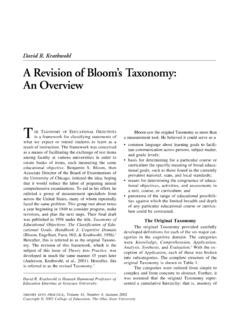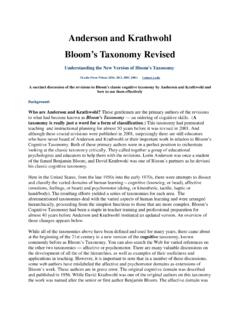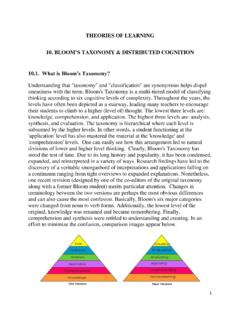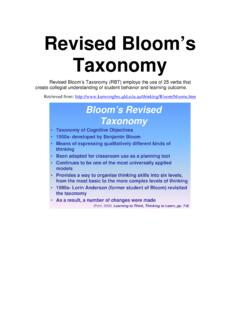Transcription of A Critical Appraisal of Bloom’s Taxonomy
1 1. IntroductionBloom s Taxonomy is a skeleton that was constructed to categorize the goals of any curriculum in terms of explicit and implicit cognitive skills and abilities. This Taxonomy is regarded as one of the crucial models that contribute to the curriculum development in the 21st century. In this vein, a search engine presents more than 817,000 results for the keyword bloom s Taxonomy . bloom s Taxonomy perseveres in and survives against the time. It has been expanded, elaborated, and interpreted in various ways and its breadth has been expounded on. As a result of searches and studies on original Taxonomy , many comments and implementations which are different in certain ways are presented form drafting work to broadened instructions. Despite the varieties, only one revision is accepted (Forehand, 2005).This revision was designed by an old student of bloom , Lorin W. Andreson and David R. Krathwohl (2003), who is one of the designers of the original 1999, Dr.
2 Lorin Anderson, a former student of bloom s, and his colleagues published an updated version of bloom s Taxonomy that takes into account a broader range of factors that have an impact on teaching and learning. This revised Taxonomy attempts to correct some of the problems with the original Taxonomy . Unlike the 1956 version, the revised Taxonomy differentiates between knowing what, the content of thinking, and knowing how, the procedures used in solving problems. The Knowledge Dimension is the knowing what. It has four categories: factual, conceptual, procedural, and metacognitive. Factual knowledge includes isolated bits of information, such as vocabulary definitions and knowledge about specific details. Conceptual knowledge consists of systems of information, such as classifications and categories. Procedural knowledge includes algorithms, heuristics or rules of thumb, techniques, and methods as well as knowledge about when to use these procedures. Metacognitive knowledge refers to knowledge of thinking processes and information about how to manipulate these processes effectively.
3 The Cognitive Process Dimension of the revised bloom s Taxonomy like the original version has six skills. Research Article Open AccessA Critical Appraisal of bloom s TaxonomySeyyed Mohammad Ali Soozandehfar (PhD)Assistant Professor of TEFLH ormozgan University, Bandar Abbas, Reza Adeli (MA)University Instructor of English Language and LiteratureHormozgan University, Bandar Abbas, investigation intends to criticize bloom s original and revised taxonomies which has been utilized since 1956 and was revised in 2001, respectively. First, this study goes through the description of the original and the revised taxonomies. Second, it starts explaining the major criticisms on bloom s original Taxonomy . Third, it also explicates a number of criticisms on the revised Taxonomy . Moreover, the article wraps up the criticisms with several ancillary criticisms, in general.
4 Furthermore, the study summarizes all the major criticisms in the form of a figure. Finally, some implications are proposed for those who tend to apply bloom s Taxonomy in their : bloom , Taxonomy , revised Taxonomy , Original Taxonomy , Criticism, Critical Page 1 American Research Journal of English and Literature(ARJEL) ISSN(online)- 2378-9026 Volume 2, 2016 1- 9 are, from simplest to most complex: remember, understand, apply, analyze, evaluate, and create. Remembering consists of recognizing and recalling relevant information from long-term memory. Understanding is the ability to make your own meaning from educational material such as reading and teacher explanations. The sub-skills for this process include interpreting, exemplifying, classifying, summarizing, inferring, comparing, and explaining. The third process, applying, refers to using a learned procedure either in a familiar or new situation. The next process is analysis, which consists of breaking knowledge down into its parts and thinking about how the parts relate to its overall structure.
5 Students analyze by differentiating, organizing, and attributing. Evaluation, which is at the top of the original Taxonomy , is the fifth of the six processes in the revised version. It includes checking and critiquing. Creating, a process not included in the earlier Taxonomy , is the highest component of the new version. This skill involves putting things together to make something new. To accomplish creating tasks, learners generate, plan, and produce. According to this Taxonomy , each level of knowledge can correspond to each level of cognitive process, so a student can remember factual or procedural knowledge, understand conceptual or metacognitive knowledge, or analyze metacognitive or factual knowledge. According to Anderson and his colleagues, Meaningful learning provides students with the knowledge and cognitive processes they need for successful problem solving . The following figure compares bloom s original Taxonomy (1956) with the revised version (2001).
6 Fig1. Comparison of bloom s original and revised taxonomies2. CriticismsToday s world is a different place, however, than the one bloom s Taxonomy reflected in 1956. Educators have learned a great deal more about how students learn and teachers teach and now recognize that teaching and learning encompasses more than just thinking. It also involves the feelings and beliefs of students and teachers as well as the social and cultural environment of the classroom. Several cognitive psychologists have worked to make the basic concept of a Taxonomy of thinking skills more relevant and accurate. In developing his own Taxonomy of educational objectives, Marzano (2000) points out one criticism of bloom s Taxonomy . The very structure of the Taxonomy , moving from the simplest level of knowledge to the most difficult level of evaluation, is not supported by research. A hierarchical Taxonomy implies that each higher skill is composed of the skills beneath it; comprehension requires knowledge; application requires comprehension and knowledge, and so on.
7 This, according to Marzano (2000), is simply not true of the cognitive processes in bloom s Taxonomy . The originators of the original six thinking processes assumed that complex projects could be labeled as requiring one of the processes more than the others. A task was primarily an analysis or an evaluation task. This has been proven not to be true which may account for the difficulty that educators have classifying challenging learning activities using the Taxonomy . Anderson (2000) argues that nearly all complex learning activities require the use of several different cognitive skills. Like any theoretical model, bloom s Taxonomy has its strengths and weaknesses. Its greatest strength American Research Journal of English and Literature(ARJEL)Volume 2016 Page 2is that it has taken the very important topic of thinking and placed a structure around it that is usable by practitioners.
8 Those teachers who keep a list of question prompts relating to the various levels of bloom s Taxonomy undoubtedly do a better job of encouraging higher-order thinking in their students than those who have no such tool. On the other hand, as anyone who has worked with a group of educators to classify a group of questions and learning activities according to the Taxonomy can attest, there is little consensus about what seemingly self-evident terms like analysis, or evaluation mean. In addition, so many worthwhile activities, such as authentic problems and projects, cannot be mapped to the Taxonomy , and trying to do that would diminish their potential as learning opportunities. In the following sections, this study presents several in-depth Criticisms on bloom s Original AnachronismQuite a few new theories and approaches have been involved in the literature as a result of researches carried out in educational and psychological terms since the date when bloom s Taxonomy was published.
9 Theory and approaches such as constructivism, metacognitive skills and self-regulated learning affect the educational process, support autonomous learning and cognitive and perceptual necessity of being responsible of the learning process. These theories and approaches clear up the necessity of the Taxonomy revision (Amer, 2006). Today s world is different from bloom s Taxonomy that reflects features of 1956. In this day and time educators have more knowledge about how learning takes place and how teachers lecture (Startalk, 2009). In this case, the shortcoming of the Taxonomy and the need for an appropriate structure to become a learner-centered becomes AgglomerationBloom s Taxonomy has an additive sort of structure. It steps forward based on the degree of difficulty, and according to the need to activate a former one for the next step. There is chiseled ranking of sections. The Taxonomy presents its cognitive process in categories.
10 They are different from each other just in terms of difficulty. However, the rigid hierarchy between categories was later softened up and overlapping between categories was provided (Krathwohl, 2002). Lack of Constructivist IntegrationConstructivism emphasizes how students create knowledge while they are busy with meaningful learning. Constructing process requires both comparing new information with old ones and using necessary various cognitive processes for this information. In this Taxonomy , students may not be able to participate in an active way in learning process. Students might not be able to select the information themselves and form their own meaning on their own. In this Taxonomy , it is essential for some students to reach up the top level. Today, it is expected that every student should make progress on an integrative basis. For this reason, combining program objectives, teaching, and assessment is more crucial than ever merged (Pickard, 2007). Unilateral LevelsKnowledge level consists of both noun and verb forms in the Taxonomy .















